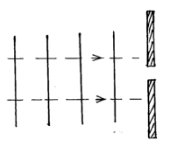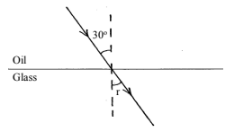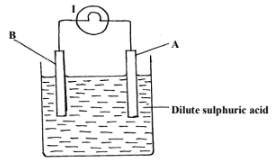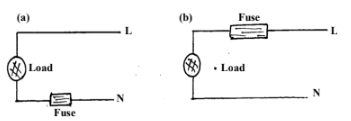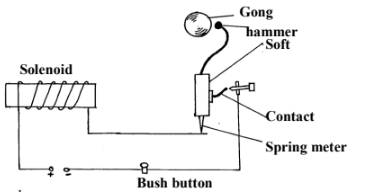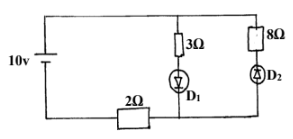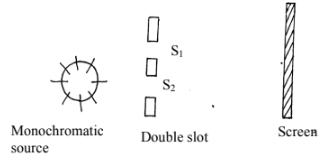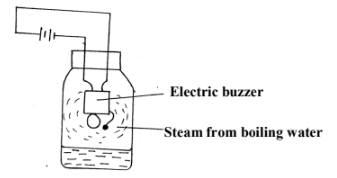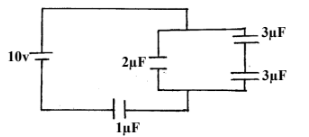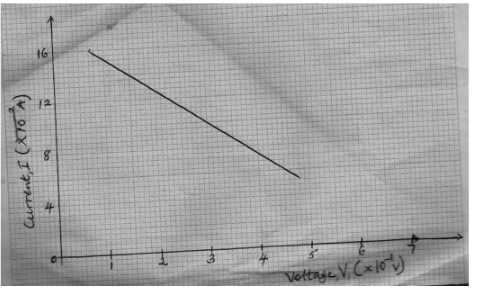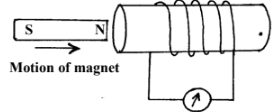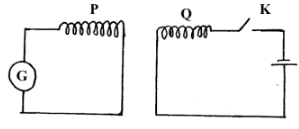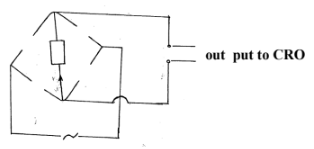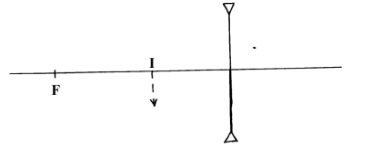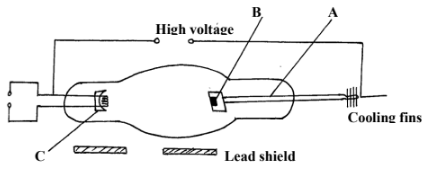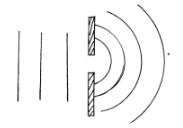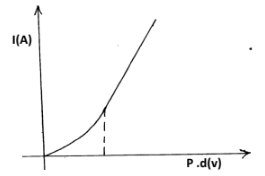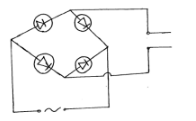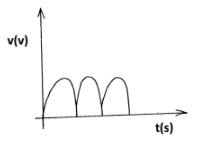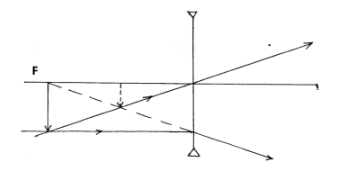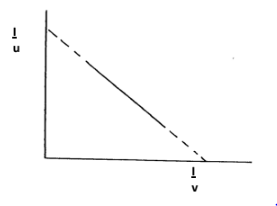INSTRUCTIONS TO CANDIDATES
- Mathematical tables and non-programmable calculators may be used.
- This paper consists of section A and section B.
- Attempt all the questions in the spaces provided.
- ALL working MUST be clearly shown.
SECTION A (25 MARKS)
- The figure below shows a series of wavefronts one wavelength apart approaching a gap between two barriers in aripple tank
Show on the figure what happens as the waves pass the gap. (1mk) - A mine worker stands between two vertical cliffs 400m from the nearest cliff. The cliff are x and metres apart. Every time he strike the rock once , he hears two echoes, the first one after 2.5 seconds, while the second follows 2 seconds later.
Calculate- The speed of sound in air. (2mks)
- The value of x (3mks)
- The coil of an electric motor is usually round on a soft iron armature. State the purpose of soft iron armature. (1mk)
- The diagram below shows a ray of light incident on a glass-oil interface.
If the refractive indices of oil and glass are 6/3 and 3/2 respectively, determine the value of r (3mks) - The figure shows a simple cell.
Use the information on the figure to answer the questions below.- Name the parts labeled A and B (1mk)
- It is observed that the bulb goes off after a short time. Explain this observation (2mks)
- The figure below shows how a fuse may be connected in electric current
In either case the fuse blows out but (a) is dangerous while (b) is not. Explain (2mks) - The figure shows a simple circuit diagram of an electric bell.
Explain how it works (2mks) - The figure shows part of electromagnetic spectrum
Arrange the electromagnetic waves in the order of decreasing energy. (1mk)Ultra violet rays Micro wave x-rays Red light - State one advantage of using optical fibres in communication. (1mk)
- Find the current flowing and voltage across the 8Ω resister in the circuit. (3mks)
- The following is part of radio active decay series.
Determine the value of a and b (2mks) - State one property of cathode rays. (1mk)
SECTION B (55MARKS)
Answer all the questions in this section
-
- In the experiment to observe interference of light waves a double slit is placed close to the source see figure.
- State the function of the double slit. (1mk)
- State and explain what is observed on the screen. (3mks)
- State what is observed on the screen when:
- The slit separation S1S2 is reduced. (1mk)
- White light source is used in place of monochromatic source. (1mk)
-
- The figure below shows a set up by a student.
State and explain what happens to the sound from the buzzer as the bottle and its contents are cooled to 0°C (3mks) - In the pipe below complete the diagram to show how air in the open pipe vibrate with a frequency of first overtone. (1mk) Open pipe
- The figure below shows a set up by a student.
- In the experiment to observe interference of light waves a double slit is placed close to the source see figure.
-
- The figure below shows an arrangement of capacitor connected to a 10V DC supply.
Determine- The combined capacitance of the arrangement. (3mks)
- The total energy stored. (2mks)
- The graph below shows the variation of potential difference V with current, I for a certain cell.
From the graph determine:- Internal reaction of the cell. (3mks)
- The e.m.f of the cell (2mks)
- The figure below shows an arrangement of capacitor connected to a 10V DC supply.
-
-
- State the Lenz’s law of electromagnetic induction. (1mk)
- Use the law to determine the direction of the induced current in the circuit below (1mk)
- Two identical coils P and Q are placed close to each other as shown.
State the observation on the galvanometer made when the switch K is closed. (1mk) - A student designed a transformer to provide power to an electric bell marked 24W, 6V from a 240V mains. He wound 50 turns and N turns on an iron ring. When he a connected the coil of 50 turns to the bell and the N turns coil to an a.c, he found that the transformer was only 60% efficient. Find:
- The value of N (2mks
- The power in the coil with N turns (2mks )
-
-
-
- With the aid of a diagram differentiate between forward biased and reverse biased diode. (2mks)
- Sketch a graph to show how a current through a forward biased p-n function varies with potential difference across it. (2mks)
- The figure below shows an incomplete circuit for full wave rectification
- Complete the diagram to show how the diodes should be arranges for the current to flow through R in the direction shown with an arrow. (2mks)
- Sketch the output voltage as observed in the CRO (1mk)
-
-
- Complete the diagram below indicating the rays that will lead to the formation of the image I shown below and locate the object position (2mks)
- An object is placed 12cm from a convex lens and it forms a virtual image 36cm from the lens calculate the focal length of the lens. (3mks)
- The graph below shows variation of I/u (cm-1) with I/v(cm-1) for an object placed infront of a concave mirror.
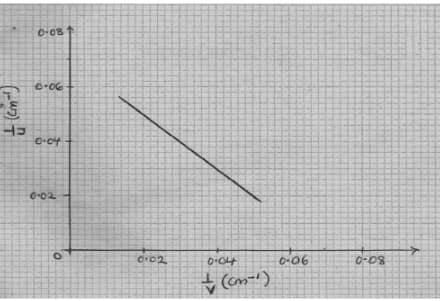
From the graph,- Determine the focal of the mirror. (2mks)
- Determine the image distance when the object is 20cm from the mirror. (2mks)
- Complete the diagram below indicating the rays that will lead to the formation of the image I shown below and locate the object position (2mks)
-
- The graph below shows stopping potential V against frequency for a photocell.
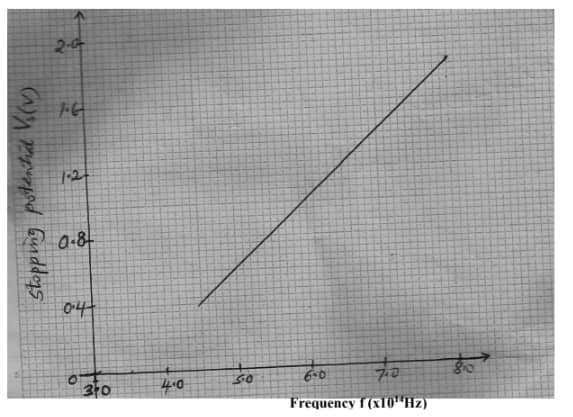
From the graph determine:- Threshohd frequency (1mk)
- Planck’s constant (2mks)
- Work function of the metal (2mks) (take e = 1.6 x 10-19c)
- The figure below shows an x-ray tube.
- Indicate on the diagram the path of the x-ray beam supplied by the tube. (1mk)
- Why is B set at an angle of 45orelative to the electron beam. (1mk)
- Why are cooling pins necessary (1mk)
- Why is the tube evacuated. (1mk)
- State the function of the part labeled C (1mk)
- The graph below shows stopping potential V against frequency for a photocell.

MARKING SCHEME
-
-
- speed= 2d/t
= 400 x 2
2.5 √
= 320 m/s √ - 320 = 2 (x − 400)
4.5 √
x − 400 = 320 x 4.5
2
X − 400 =720
x = 1120m √
- speed= 2d/t
- To concentrate the magnectic √ field for maximum time linkage
- n1 sin θ1= n2 sin θ2
6/3 sin30° = 3/2 sin r √1
Sin r = 2/3 x 6/3 sin 30
= 0,667
r= 41.8130° √1 -
- A – zinc
B- copper - The bulb goes off because of a simple cell polarization and local action
- A – zinc
- In (a) the load is before the fuse so blowing out the fuse does not cut off power from the load . ie the load is still at a higher temperature while in (b) the fumes is before the load so melting of the fumes disconnects the load from the power √1
- Pushing the button completes the current making the solenoif to be magnetized .The soft iron armature is attracted towards the solenoid making the hammer to strike the gong .this brakes the contact demagnetizing the solenoid hence the armature is pulled back by the spring . The process repeats itself
- x-rays → uv rays → red light→micro waves
- more information can be transmitted at the same time
O loss of energy during transmission - RT = 3+2 = 5−2
I = v = 10 = 2A √1
RT 5
Pd across 8-2 resistor is zero - 9a = 234
a = 234
9
= 26
b+2 = 84
b=84−2
= 82 - They are charged as they can be deflected in both magnetic and electric field.
They carry energy -
-
- Is provide coherent sources √1
-
- Alternating dark and bright fringes√1
- Dark fringes due to destructive interference√1
- Bright fringes due to constructive interference√1
-
- Increased distance between the fringes √1
- Coloured fringes are formed√1
-
- Sound becomes fainter√1 on cooling ,steam condenses creating vacuum hence cant be transmitted √1
-
-
-
-
- = 3.5(i) √1
4.5
= 0.778mf √1 - E = ½cv2 √1
= ½(3.5/4.5)10 x 10-6√1
= 3.89x 10-5√1
- = 3.5(i) √1
-
- –v = 1
slope
= 12 - 8
2.6 – 4 √1
= 0.352Ω √1 - E = 6.8 x 10-1 v √1
- –v = 1
-
-
-
- Lenz-Ten – the direction of induced current thick that is opposes the causing it √1
-
√1
- deflects momentarily√1
-
- Ns = Vs
Np Vp
50/N = 6/240√1
N= 2000 turns√1 - pour/pin x 100%
60 x 24 x 100 √1
Pin
=40 W √1
- Ns = Vs
-
-
-
- In forward braising p- region is connected to positive terminal of external power wher n- region is connected to negative terminal to potential barrier reduced
- in reverse bias of potential barrier increased
-
-
-
-
- u = 12cm
v = - 36cm
u = 1/u+1/v
f
=1/12 +1/-36
= 1/12 – 1/36
3-1
36
= 2/36
F= 36/2
= 18 cm -
- I/u – intercept = 0.07
I/f = 0.07
f = 0.07 = 1/0.07
= 14.29cm - 1/f = 1/u + 1/v
1 = 1 + 1
14.29 20 v
1/V = 1/14.29 − 1/20
= 0.07 – 0.05
= 0.02
V = 1/0.02
= 50cm
- I/u – intercept = 0.07
-
-
- fo = 3.5 x 1014 H2
- h/e = slope
h = 6,737x 10-34 x 3.5 x 1014
= 2.358 x 10-17 - Wo = hfo
6.737 x 10-34 x 3.5 x 1014
2.358 x 10-17J
-
-
- for x-ray beam to pass through the window √1
- cools the arrode√1
- prevents collision between electrons and air √1
- force electrons onto the target√1
-
-
Download Physics Paper 2 Questions And Answers - Form 4 Term 2 Opener 2021.
Tap Here to Download for 50/-
Get on WhatsApp for 50/-
Why download?
- ✔ To read offline at any time.
- ✔ To Print at your convenience
- ✔ Share Easily with Friends / Students

